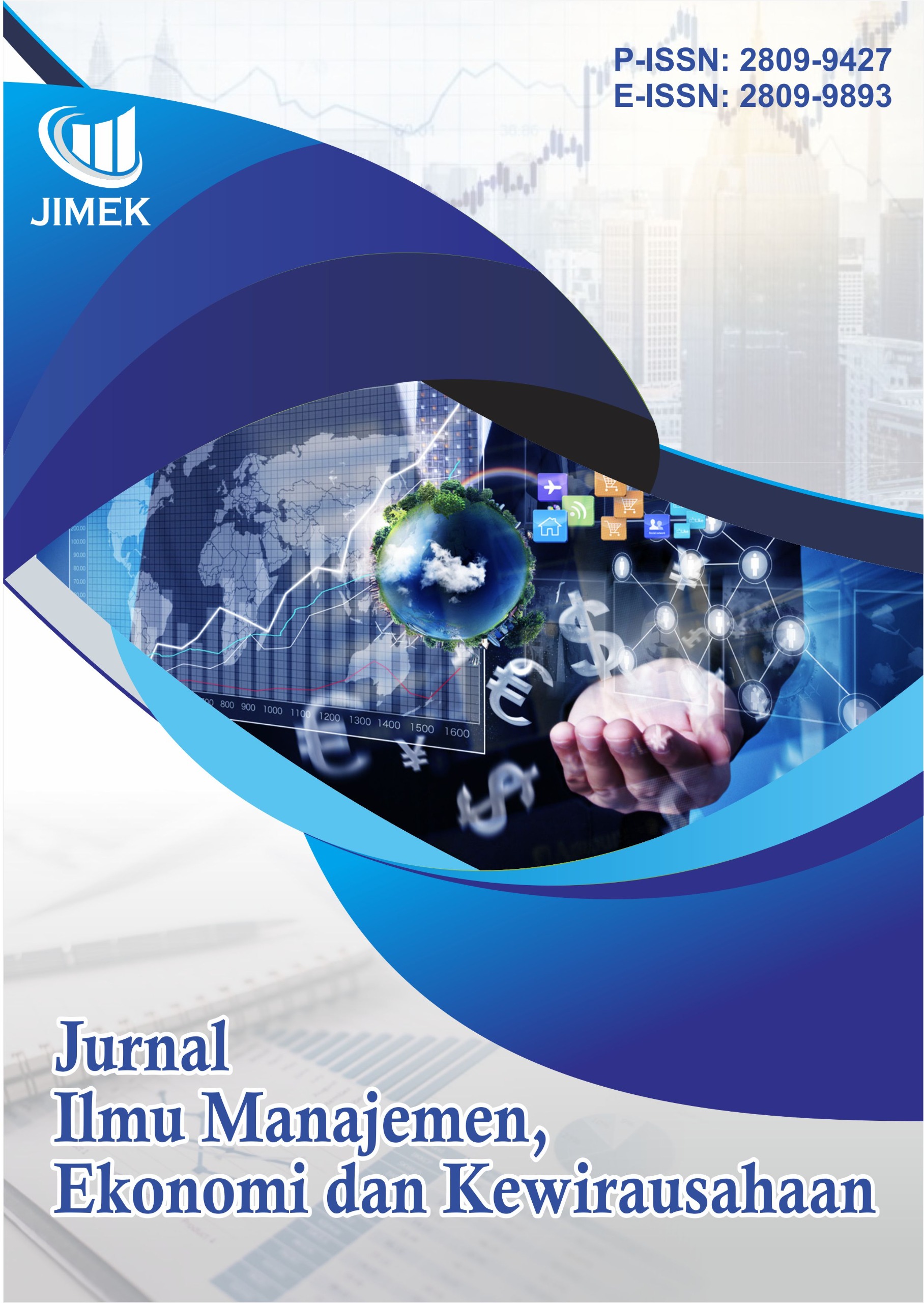Arti Strategis Membangun Merek yang Kuat (Tinjauan Literatur)
DOI:
https://doi.org/10.55606/jimek.v5i3.7859Keywords:
Brand Strategy, Literature Review, Loyalty, Strategic Meaning, Strong BrandAbstract
A brand can enhance a company's ranking, on the one hand, and consumers' status in society, on the other. The purpose of this paper is to further elaborate on the strategic significance of strong brand building efforts. The research design used in this study is a literature review. The data sources used are journals and/or websites related to the selected topic. The data sources for this study consist of journal articles on the strategic significance of brands. The data analysis technique used is content analysis. Companies in developing countries like Indonesia are increasingly recognizing the benefits of building strong brands, such as surviving difficult economic conditions, enjoying longer lifespans, gaining greater power in distribution channels, expanding sales beyond small domestic markets, becoming more competitive in staff recruitment and retention, and increasing profits. Brand strength plays a crucial role in determining business success, as it significantly shapes customer behavior, engagement, and loyalty. This is because a strong brand has strategic significance as a valuable asset for companies in making business decisions. By understanding and leveraging brand strength, companies can develop strategies that maximize their brand's potential and drive business growth. Furthermore, strong brand building plays a role in creating sustainable differentiation amidst increasingly fierce market competition. In today's digital age, consumers buy products not only based on their function but also on the values, image, and story behind the brand. Therefore, an effective brand strategy focuses not only on visuals or communication but also reflects the company's core values that are relevant to consumer expectations and aspirations.
References
AMA. (1948). Report of the Definitions Committee. Journal of Marketing, 13(2), 202–217. https://doi.org/10.1177/002224294801300208
Audretsch, D. B., & Fiedler, A. (2023). Power and entrepreneurship. Small Business Economics, 60(4), 1573–1592. https://doi.org/10.1007/s11187-022-00660-3
Brown, G. (1992). People, brands and advertising. Millward Brown International.
Cahyono, A. D. (2020). Studi kepustakaan mengenai kualitas pelayanan terhadap kepuasan pasien rawat jalan rumah sakit. Jurnal Ilmiah Pamenang, 2(2), 1–6.
Chattopadhyay, A., Batra, R., & Ozsomer, A. (2012). The new emerging market multinationals: Four strategies for disrupting markets and building brands. McGraw-Hill.
Conejo, F., & Wooliscroft, B. (2015). Brands defined as semiotic marketing systems. Journal of Macromarketing, 35(3), 287–301. https://doi.org/10.1177/0276146714531147
de Chernatony, L., & McDonald, M. (1994). Creating powerful brands. Butterworth-Heinemann.
Dimofte, C. V., Johansson, J. K., & Ronkainen, I. A. (2008). Cognitive and affective reactions of U.S. consumers to global brands. Journal of International Marketing, 16(4), 113–135. https://doi.org/10.1509/jimk.16.4.113
Edelman. (2022). Edelman trust barometer. https://www.edelman.com/trust/2022-trust-barometer
Gardner, B. B., & Levy, S. J. (1955). The product and the brand. Harvard Business Review, 33, 33–39.
Giesler, M., & Veresiu, E. (2014). Creating the responsible consumer: Moralistic governance regimes and consumer subjectivity. Journal of Consumer Research, 41(3), 840–857. https://doi.org/10.1086/677842
Henderson, P. W., Cote, J. A., Leong, S. M., & Schmitt, B. (2003). Building strong brands in Asia: Selecting the visual components of image to maximize brand strength. International Journal of Research in Marketing, 20(4), 297–313. https://doi.org/10.1016/j.ijresmar.2003.03.001
Kotler, P., Keller, K. L., Cerven, A., Sheth, J. N., & Shainesh, G. (2025). Marketing management (17th ed.). Pearson Education.
Kumar, N., & Steenkamp, J.-B. E. M. (2013). Brand breakout: How emerging market brands will go global. Palgrave Macmillan.
Liu, T., Liu, X., Men, Y., & Zhang, X. (2023). Research on global supply chain model of multinational corporations based on global production network theory—Apple Corporation as an example. Highlights in Business, Economics and Management, 8, 271–277. https://doi.org/10.54097/hbem.v8i.7219
Marzali, A. (2016). Menulis kajian literatur. Jurnal Etnosia, 1(2), 112–117.
Moorman, C. (2019). Why Apple is still a great marketer and what you can learn. Forbes. https://www.forbes.com/sites/christinemoorman/2018/01/12/why-apple-is-still-a-great-marketer-and-what-you-can-learn/
Nigam, I. (2023). Marketing strategies of Apple Inc. International Journal for Multidisciplinary Research, 5(2). https://doi.org/10.36948/ijfmr.2023.v05i02.2059
Özsomer, A. (2012). The interplay between global and local brands: A closer look at perceived brand globalness and local iconness. Journal of International Marketing, 20(2), 72–95. https://doi.org/10.1509/jim.11.0105
Özsomer, A., Batra, R., & Steenkamp, J.-B. E. M. (2024). Brands and branding around the world. Journal of International Marketing, 32(3), 1–4. https://doi.org/10.1177/1069031X241265816
Prayustio, H. B., & Wilujeng, I. P. (2024). Brand power: The ability of brands to influence consumer behaviour (pp. 91–100). https://doi.org/10.2991/978-94-6463-576-8_8
Shao, Z., & Ngai, C. S. (2023). Why and how effective brand logo contributes to marketing? Advances in Economics, Management and Political Sciences, 13(1), 17–22. https://doi.org/10.54254/2754-1169/13/20230661
Spielmann, N., Williams, C., & Kohli, A. K. (2024). Local roots and global responsibility: Terroir brands and their responsible engagement. Journal of International Marketing, 32(3), 65–82. https://doi.org/10.1177/1069031X231205255
Steenkamp, J.-B. (2017). Global brand strategy: World-wise marketing in the age of branding. Palgrave Macmillan.
Vredenburg, J., Kapitan, S., Spry, A., & Kemper, J. A. (2020). Brands taking a stand: Authentic brand activism or woke washing? Journal of Public Policy & Marketing, 39(4), 444–460. https://doi.org/10.1177/0743915620947359
Wood, L. (2000). Brands and brand equity: Definition and management. Management Decision, 38(9), 662–669. https://doi.org/10.1108/00251740010379100
Xie, Y., Batra, R., & Peng, S. (2015). An extended model of preference formation between global and local brands: The roles of identity expressiveness, trust, and affect. Journal of International Marketing, 23(1), 50–71. https://doi.org/10.1509/jim.14.0009
Downloads
Published
How to Cite
Issue
Section
License
Copyright (c) 2025 Jurnal Ilmu Manajemen, Ekonomi dan Kewirausahaan

This work is licensed under a Creative Commons Attribution-ShareAlike 4.0 International License.








